
Ronja Storm delivery is delayed by a month
Tasmanian salmon farmer Huon Aquaculture will have to wait a few more weeks for the arrival of the world’s biggest wellboat, the Ronja Storm, in its waters.
The vessel, which is owned by Norwegian wellboat company Sølvtrans and will be on a fixed contract with Huon, was due to be completed by the end of September.
But Sølvtrans chief Roger Halsebakk told Fish Farming Expert’s Norwegian sister site, Kyst.no, that work was taking a longer than envisaged.
“The boat is delayed until October 26,” he said.
Producing freshwater
The Ronja Storm’s Turkish-built hull arrived in Leirvik in February for fitting out. When everything is completed, the vessel will undertake an approximately 50-day voyage to the other side of the globe. For safety reasons the ship will go via the Panama Canal.
The Ronja Storm has been designed to handle the specific challenges facing Tasmanian farming. Freshwater is limited in Tasmania, and the vessel can produce its own freshwater to treat amoebic gill disease, which is a problem for Australian salmon farmers.
Ronja Storm’s ability to generate freshwater and the large capacity of its 5,500m³ freshwater tanks allow it to treat the big cages used.
Its fish tanks have a capacity of 7,450m³.
Very large cages
“There are quite a lot of challenges with AGD in Tasmania. In addition, the cages there are normally very large, typically 240 metres in circumference. They can easily hold up to 1,000 tonnes,” Sølvtrans development manager Tor Ove Stenersen told Kyst.no earlier this year.
“Freshwater is a scarce resource and expensive and one has to go far to get it. Lately, the emphasis within the aquaculture industry in Tasmania has been moving further and further south towards open water. Then it is a great advantage to be able to produce their own treatment water.
“Produced water is also of better quality, which means that one can have a greater density of fish than if one used river water.”
Loss of appetite
Stenersen expalined that treatments against AGD in Tasmanina are often required to be done once a month, which can mean as much as 15 times during the production period, with a consequent impact on the appetetite of the fish, who can stop for eating for days afterwards.
“That is why it is important to reduce this stress. Being able to process all the fish in the cage at the same time is therefore important,” Stenersen said.
The Ronja Storm’s specifications are far larger than most other wellboats, but it won’t hold the title of biggest wellboat for long. Another Norwegian wellboat company, Frøy Rederi, is having a vessel constructed with a fish tank capacity of 7,500m³, which is 50m³ more than the Sølvtrans flagship.
Frøy Rederi’s wellboat will be 83.72 metres long and 30.9 metres wide, making it shorter and fatter than the Ronja Storm, which is 116.2m long and 23m wide.






















































